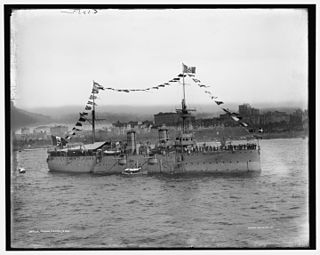See also
- HMS Aetna, British ships
- Etna-class corvette, Napoleonic corvettes of France
Several ships of the Italian Navy have been named Etna, after Mount Etna in Sicily:
Mount Etna is an active volcano on the east coast of Sicily.
Eight ships of the Royal Navy have been named HMS Challenger, most famously the fifth, the survey vessel Challenger that carried the Challenger expedition from 1872 to 1876.
Ten ships of the Royal Navy have been named HMS Aetna or HMS Etna, after the volcano Etna:
Primauget may refer to one of the following ships of the French Navy named in honour of Hervé de Portzmoguer:
Four ships of the Royal Navy have borne the name HMS Chester, after the city of Chester:

The Etna class were two cruisers originally ordered in Italy for the Thai Navy in 1938 and subsequently requisitioned for service by the Italian Navy on the outbreak of World War II, neither ship was completed and the damaged hulls were scrapped after the war.
Six ships of the English Navy or the Royal Navy have borne the name Encounter or HMS Encounter:

The Etna class was a series of protected cruisers that were built in the late 1880s for the Regia Marina. The four ships built were slightly enlarged copies of the Elswick Works' design for the protected cruiser Giovanni Bausan. Etna, the lead ship of the class, was the only ship still in service when World War I began, although she served as a stationary headquarters ship for the Navy Commander-in-Chief in Taranto for the duration of the war. The three later ships all participated in putting down the Boxer Rebellion as part of the Eight-Nation Alliance. The three were struck from the Navy List before 1912, but Etna was not sold for scrap until 1921.
Three ships of the Imperial German Navy have been named SMS Prinz Adalbert:
At least five ships in the Imperial Russian, Soviet or Russian Navies have been named Varyag after the Varangian people, the Viking ancestors of the Rus.

Etna was a protected cruiser of the Italian Regia Marina built in the 1880s. She was the lead ship of the Etna class, which included three sister ships. Named for Mount Etna on the island of Sicily, the ship was laid down in January 1883, was launched in September 1885, and was completed in December 1887. She was armed with a main battery of two 254 mm (10 in) and a secondary battery of six 152 mm (6 in) guns, and could steam at a speed of around 17 knots.

Caprera was a torpedo cruiser of the Partenope class built for the Italian Regia Marina in the 1880s. She was built by the Cantiere navale fratelli Orlando shipyard; her keel was laid in July 1891, she was launched in May 1894, and was commissioned in December 1895. Her main armament were her five torpedo tubes, which were supported by a battery of eleven small-caliber guns. Caprera spent most of her career in the main Italian fleet, where she was primarily occupied with training exercises. She served in the Red Sea during the Italo-Turkish War of 1911–1912, where she conducted shore bombardments and blockaded Ottoman ports in the area. Caprera did not remain in service long after the war, being sold for scrap in May 1913.
Minerva has been borne by at least three ships of the Italian Navy and may refer to:
Urania has been borne by at least three ships of the Italian Navy and may refer to:
Stromboli has been borne by at least four ships of the Italian Navy:
Three ships of the German Kaiserliche Marine have been named SMS Leipzig, after the Battle of Leipzig: